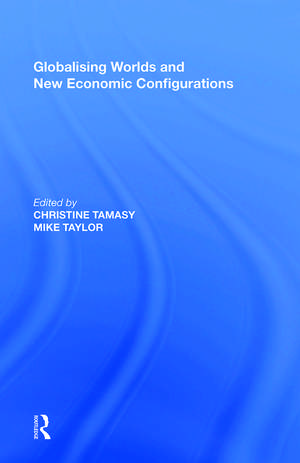Globalising Worlds and New Economic Configurations
Autor Christine Tamasyen Limba Engleză Paperback – 31 mar 2021
Preț: 369.14 lei
Nou
Puncte Express: 554
Preț estimativ în valută:
70.63€ • 73.60$ • 58.49£
70.63€ • 73.60$ • 58.49£
Carte tipărită la comandă
Livrare economică 03-17 aprilie
Preluare comenzi: 021 569.72.76
Specificații
ISBN-13: 9780367787141
ISBN-10: 0367787148
Pagini: 328
Dimensiuni: 152 x 229 x 18 mm
Greutate: 0.44 kg
Ediția:1
Editura: Taylor & Francis
Colecția Routledge
Locul publicării:Oxford, United Kingdom
ISBN-10: 0367787148
Pagini: 328
Dimensiuni: 152 x 229 x 18 mm
Greutate: 0.44 kg
Ediția:1
Editura: Taylor & Francis
Colecția Routledge
Locul publicării:Oxford, United Kingdom
Cuprins
Contents: Researching new economic configurations: theory and context, Christine Tamásy and Mike Taylor; Impeding industrial development? Regional trade arrangements as response to quota abolition in the textile and garment industry, Hege Merete Knutsen; Crossing juridical borders: relational governance in international package tourism from Germany to Jordan, Sabine Dörry; Global distribution and cluster development: Hollywood and the German connection, Ivo Mossig; Foreign direct investments in development strategies: Norwegian FDI and the tendency for agglomeration, Arnt Fløysand and Håvard Haarstad; Multinational investment in UK regions, Dimitra Dimitropoulou, Simon Burke and Philip McCann; Globalising commercial property markets: the development and evolution of the listed property trust sector in New Zealand, Laurence Murphy; The new international division of labour and the changing role of the periphery: the case of the Polish automotive industry, Boleslaw Domanski, Robert Guzik and Krzysztof Gwosdz; Toyotaism travels to Poland: a case study of a hybrid factory, Tomasz Majek and Roger Hayter; Spatial division of competencies and local upgrading in the automotive industry: conceptual considerations and empirical findings from Poland, Johannes Winter; Analysis of the automobile cluster in a multi-dimensional spatial framework: the case of Ulsan, Jeong Hyop Lee; The identification of potential cluster areas using local indexes of spatial autocorrelation, Michael C. Carroll, Bruce W. Smith and Joseph P. Frizado; The role of an antecedent cluster, academic R&D and entrepreneurship in the development of Toledo's solar energy cluster, Frank J. Calzonetti; The restructuring of metal manufacturing in the West Midlands region of the UK: an emerging new geography, Michael Taylor and John Bryson; Labour market intermediation, James W. Harrington and Nicholas Velluzzi; Globalisation, skilled migration and the mobility of knowledge, Christine Tamásy; Rural development
Descriere
Over the last few decades, circuits of capital have been stretched through processes of economic globalization, leading to complex and hybrid outcomes that result in different modes of production and consumption
